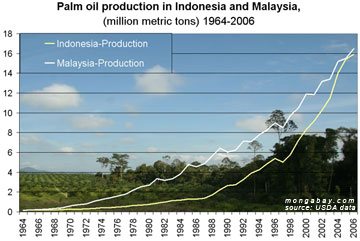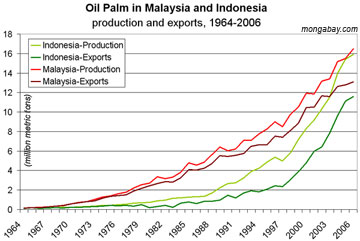Investigation finds destruction of orangutan habitat for oil palm in Borneo
Investigation finds destruction of orangutan habitat for oil palm in Borneo
mongabay.com
September 2, 2007
 Chart showing annual palm oil production by Malaysia and Indonesia from 1964-2006. Click to enlarge. |
An Associated Press investigation found evidence of workers opening up rainforest land for new oil palm plantations in the heart of Borneo.
According to the AP, a leading plantation firm, Singapore-based Wilmar International Ltd., admitted to clearing trees on forest land, though said it does not clear “high value rain forests” for development.
AP writer Chris Brummitt reports:
-
An Associated Press team spent several days touring Borneo’s palm oil heartland in central Kalimantan province, visiting areas where workers were opening up thick jungle land to extend existing plantations or create new ones.
The status of the land was not clear, but massive trees were among those being cut, in some cases workers had piled up the valuable timber by the side of the road, presumably awaiting transport to sell them.
At one plantation owned by a subsidiary of Singapore-based Wilmar International Ltd. police had taped off several large logs, suggesting they were being used as part of an investigation.
The company, which has been accused by Friends of the Earth of bad environmental practice on Borneo, said it does not clear “high value rain forests” for development but will sometimes clear trees on degraded land.
 Orangutan in Kalimantan. By Rhett A. Butler |
Environmentalists say the booming biofuels market — oil palm is presently the world’s most productive energy crop — is driving the rapid destruction of Indonesia’s dwindling rainforests. The UN estimates that agricultural expansion and logging could destroy 98 percent of orangutan habitat by 2022.
While the Indonesian government says it prohibits plantations in virgin forests, it has had little success reigning in developers. Corruption at the provincial and village level is also rampant.
Oil palm can be grown in degraded forest areas, but developers prefer to clear forest because the logging revenue can offset the costs of establishing a plantation. Because oil palms take 2-4 years to start producing oilseed used for palm oil biodiesel, plantations have relatively large up-front costs.
 Chart showing annual palm oil production and exports by Malaysia and Indonesia from 1964-2006. Click to enlarge. |
The industry has rapidly expanded in recent years with Indonesian oil palm production growing from 157,000 metric tons in 1964 to 15.9 million metric tons in 2006. Exports climbed from 126,000 metric tons to 11.6 million metric tons during the same period. In Kalimantan, as Indonesian Borneo is known, oil palm plantations have increased from 13,140 hectares in 1984 to nearly one million hectares at the end of 2003. Overall, oil palm cultivation has expanded in Indonesia from 600,000 hectares in 1985 to more than 6 million hectares by early 2007, and is expected to reach 10 million hectares by 2010.
Western governments are increasingly wary about the unsustainably of oil palm cultivation in peatlands — carbon-rich wetlands — and biodiverse forest lands. Early this year the Dutch government issued a set of guidelines for “greener” palm oil production. Industry groups are also responding, developing their own certification standards for “sustainable” biofuels.
RELATED ARTICLES
NGOs should use palm oil to drive conservation
(8/29/2007) Environmentalists view the expansion of oil palm plantations in southeast Asia as one of the greatest threats to the region’s forests and biodiversity. Campaigners say oil palm is driving the conversion of tens of thousands of hectares of peatlands and lowland forest in Indonesia and Malaysia, putting wildlife at risk, increasing the vulnerability of the forests to fires, and triggering large emissions of greenhouse gases. Pressure from these groups have in recent months convinced European policymakers to reconsider sourcing energy crop production to the region.
Could peatlands conservation be more profitable than palm oil?
(8/22/2007) This past June, World Bank published a report warning that climate change presents serious risks to Indonesia, including the possibility of losing 2,000 islands as sea levels rise. While this scenario is dire, proposed mechanisms for addressing climate change, notably carbon credits through avoided deforestation, offer a unique opportunity for Indonesia to strengthen its economy while demonstrating worldwide innovative political and environmental leadership. In a July 29th editorial we argued that in some cases, preserving ecosystems for carbon credits could be more valuable than conversion for oil palm plantations, providing higher tax revenue for the Indonesian treasury while at the same time offering attractive economic returns for investors.
Indonesia: No more rainforest clearing for palm oil
(6/5/2007) Indonesian Minister for Environment Rachmat Witoelar said Indonesia will not allow palm oil producers to clear primary forests for establishing plantations, reports Bloomberg. Indonesia is expected to surpass Malaysia as the world largest producer of palm oil this year. The government hopes to add 7 million hectares of plantations by 2011.
Dutch plan restricts biofuels that damage environment
(4/29/2007) The Netherlands has proposed a system to reduce the environmental impact of biofuels production. The country becomes the first in the world to establish such guidelines. Environmentalists have expressed increasing concern for the establishment of energy crops in biodiverse and carbon-rich ecosystems like the peatlands of Indonesia and the Amazon rainforest. They say that conversion of these forests for oil palm and soybeans is threatening endangered species and worsening global warming. Further, they warn, demand for such biomass energy products is driving up prices for food crops.
Palm oil doesn’t have to be bad for the environment
(4/4/2007) As traditionally practiced in southeast Asia, oil palm cultivation is responsible for widespread deforestation that reduces biodiversity, degrades important ecological services, worsens climate change, and traps workers in inequitable conditions sometimes analogous to slavery. This doesn’t have to be the case. Following examples set forth by the Roundtable on Sustainable Palm Oil and firms like Golden Hope Plantations Berhad, a Malaysian palm oil producer, oil palm can be cultivated in a manner that helps mitigate climate change, preserves biodiversity, and brings economic opportunities to desperately poor rural populations.
Eco-friendly palm oil could help alleviate poverty in Indonesia
(4/3/2007) The Associated Press (AP) recently quoted Marcel Silvius, a climate expert at Wetlands International in the Netherlands, as saying palm oil is a failure as a biofuel. This would be a misleading statement and one that doesn’t help efforts to devise a workable solution to the multiplicity of issues surrounding the use of palm oil.
Borneo
(2/22/2007) Borneo, the third largest island in the world, was once covered with dense rainforests. With swampy coastal areas fringed with mangrove forests and a mountainous interior, much of the terrain was virtually impassable and unexplored. Headhunters ruled the remote parts of the island until a century ago. In the 1980s and 1990s Borneo underwent a remarkable transition. Its forests were leveled at a rate unparallel in human history. Borneo’s rainforests went to industrialized countries like Japan and the United States in the form of garden furniture, paper pulp and chopsticks. Initially most of the timber was taken from the Malaysian part of the island in the northern states of Sabah and Sarawak. Later forests in the southern part of Borneo, an area belonging to Indonesia and known as Kalimantan, became the primary source for tropical timber. Today the forests of Borneo are but a shadow of those of legend and those that remain are highly threatened by the emerging biofuels market, specifically, oil palm.
Saving Orangutans in Borneo
(5/24/2006) A look at conservation efforts in Kalimantan, on the island of Borneo. I’m in Tanjung Puting National Park in southern Kalimantan on the island of Borneo. At 400,000 hectares (988,000 acres) Tanjung Puting is the largest protected expanse of coastal tropical heath and peat swamp forest in southeast Asia. It’s also one of the biggest remaining habitats for the critically endangered orangutan, the population of which has been great diminished in recent years due to habitat destruction and poaching. And orangutans have become the focus of a much wider effort to save Borneo’s natural environment. We are headed to Campy Leakey, named for the renowned Kenyan paleontologist Louis Leakey. Here lies the center of the Orangutan Research Conservation Project. Established by Birute Mary Galdikas, a preeminent primatologist and founder of the Orangutan Foundation International (OFI), the project seeks to support the conservation and understanding of the orangutan and its rain forest habitat while rehabilitating ex-captive individuals. The Orangutan Research Conservation Project is the public face of orangutan conservation in this part of Kalimantan, the Indonesia-controlled part of Borneo. Borneo, the third largest island in the world, was once home to some of the world’s most majestic, and forbidding forests. With swampy coastal areas fringed by mangrove forests and a mountainous interior, much of the terrain was virtually impassable and unexplored. Headhunters ruled the remote parts of the island until a century ago.
Why is palm oil replacing tropical rainforests?
(4/25/2006) In a word, economics, though deeper analysis of a proposal in Indonesia suggests that oil palm development might be a cover for something more lucrative: logging. Recently much has been made about the conversion of Asia’s biodiverse rainforests for oil-palm cultivation. Environmental organizations have warned that by eating foods that use palm oil as an ingredient, Western consumers are directly fueling the destruction of orangutan habitat and sensitive ecosystems. So, why is it that oil-palm plantations now cover millions of hectares across Malaysia, Indonesia, and Thailand? Why has oil palm become the world’s number one fruit crop, trouncing its nearest competitor, the humble banana? The answer lies in the crop’s unparalleled productivity. Simply put, oil palm is the most productive oil seed in the world. A single hectare of oil palm may yield 5,000 kilograms of crude oil, or nearly 6,000 liters of crude.







